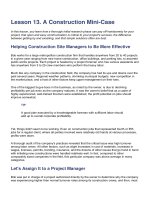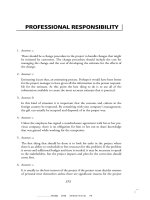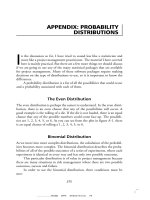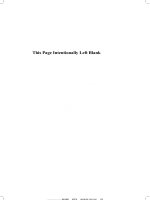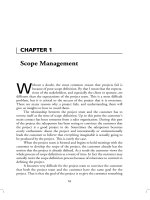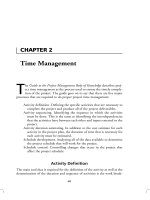Project management toolkit
Bạn đang xem bản rút gọn của tài liệu. Xem và tải ngay bản đầy đủ của tài liệu tại đây (4.13 MB, 310 trang )
Project Management Toolkit
Achieving Results That Endure In Transition Societies
Samuel Mintz, Ph.D.
Booz Allen Hamilton
+1.703.917.2480
Rafael Aldrete, Ph.D.
Booz Allen Hamilton
+1.703.902.4113
Carl Mitchell
Europe and Eurasia Bureau
U.S. Agency for International
Development (USAID)
+1.202.712.5495
South East Europe
Regional Infrastructure Program (RIP) for
Water and Transport
January 2003
© USAID
PMTOOLKIT—TEMPLATES AND TOOLS BY CHAPTER
PMTOOLKIT
CHAPTER
TEMPLATE
TOOLS
INTRODUCTION
Chapter I
HOW TO USE THE
TOOLKIT
Chapter II
Environmental Scanning
STRATEGIC
CONSIDERATIONS
SWOT
Best Practices Form
Chapter III
Personal Qualities Self-Assessment
Developing Relationships
Team Building
PEOPLE
Principled Negotiation
Chapter IV
Leadership Sociogram
Investing in Social Capital
Participation Choice
Problem Tree
Alternatives Tree
Cost Effectiveness Analysis
PROJECT
IDENTIFICATION
Chapter V
Objective Tree
Project Proposal
Document (PPD)
Stakeholder Analysis
Logical Framework
PPP Analysis
Pre-Feasibility Requirements
Cost Estimation
Indicators and Measurement
Work Breakdown Structure (WBS)
PROJECT
PREPARATION
Chapter VI
Project Appraisal
Document (PAD)
Feasibility Analysis Checklist
Feasibility Study
Risk Analysis and Mitigation Plan
Communication of a Project
USAID (copyright)
-i-
Booz Allen Hamilton
PMTOOLKIT
CHAPTER
TEMPLATE
TOOLS
Requirements and Deliverables Specification
Financing Plan
Network Scheduling
IMPLEMENTATION
PLANNING
Chapter VII
Project
Implementation Plan
(PIP)
Resource and Cost Estimating
Procurement Arrangements
Procurement Plan
Disbursement Plan
Monitoring, Reporting and Evaluation Plan
Terms of Reference (ToR)
Project Flyer
Project Organization Chart
PROJECT START-UP
Chapter VIII
Bar Charts
Inception Report (IR)
Responsibility Charts
Procurement Management Checklist
Project Information System Diagram
Launch Workshop
Contract Management Checklist
Claims Management Procedure
PROJECT
EXECUTION
Chapter IX
Periodic Monitoring and Control Report
Final Implementation
Report (FIR)
Annual Review and Planning Workshops
Mid-term and Final Evaluation Cycle
Scope Change Procedure
Project Completion Checklist
PROJECT
SUSTAINABILITY
Chapter X
Sustainability Assessment Scope of Work
Project Sustainability
Plan (PSP)
Sustainability Objectives and Indicators
Operations and Maintenance Checklist
Sustainability Assessment
CONCLUSION
Chapter XI
USAID (copyright)
- ii -
Booz Allen Hamilton
PMToolkit
Table of Contents
PROJECT MANAGEMENT TOOLKIT
TABLE OF CONTENTS
LIST OF TABLES.................................................................................................................V
LIST OF FIGURES ............................................................................................................. VI
LIST OF ABBREVIATIONS............................................................................................. XII
PREFACE .......................................................................................................................... XIV
CHAPTER I: INTRODUCTION .........................................................................................1
THE “MANAGEMENT GAP” IN INFRASTRUCTURE PROJECTS ...................................................1
PURPOSE OF THE PROJECT MANAGEMENT TOOLKIT ...............................................................2
THE PMTOOLKIT JOURNEY.....................................................................................................3
PMTOOLKIT CONCEPTS AND THE PROJECT MANAGEMENT FRAMEWORK...............................7
THE PMTOOLKIT PERSPECTIVE ............................................................................................13
ORGANIZATION OF THE PMTOOLKIT ....................................................................................14
CHAPTER II: HOW TO USE THE PMTOOLKIT .........................................................16
WHO IS THE TARGET AUDIENCE?...........................................................................................16
WHAT THE PMTOOLKIT IS NOT.............................................................................................17
HOW SHOULD THE PMTOOLKIT BE READ? ............................................................................17
HOW ARE THE PMTOOLKIT CHAPTERS STRUCTURED? ..........................................................20
CONCLUSION.........................................................................................................................24
CHAPTER III: STRATEGIC CONSIDERATIONS ......................................................25
OVERVIEW ............................................................................................................................25
TOOLS IN PERSPECTIVE .........................................................................................................26
TOOL DESCRIPTIONS:............................................................................................................29
CONCLUSION.........................................................................................................................38
CHAPTER IV: PEOPLE.......................................................................................................39
OVERVIEW ............................................................................................................................39
PEOPLE LEVELS IN A PROJECT SETTING ................................................................................40
TOOLS IN PERSPECTIVE .........................................................................................................40
TOOL DESCRIPTIONS .............................................................................................................44
CONCLUSION.........................................................................................................................74
CHAPTER V: PROJECT IDENTIFICATION.................................................................76
OVERVIEW ............................................................................................................................76
TEMPLATE: PROJECT PROPOSAL DOCUMENT (PPD) .............................................................77
TOOLS IN PERSPECTIVE .........................................................................................................81
MYCITY PROJECT CASE: PROJECT IDENTIFICATION ............................................................83
TOOL DESCRIPTIONS .............................................................................................................85
NARRATIVE SUMMARY .......................................................................................................103
ASSUMPTIONS (RISKS) ........................................................................................................104
CONCLUSION.......................................................................................................................117
USAID (copyright)
- iii -
Booz Allen Hamilton
PMToolkit
Table of Contents
CHAPTER VI: PROJECT PREPARATION...................................................................119
OVERVIEW ..........................................................................................................................119
TEMPLATE: THE PROJECT APPRAISAL DOCUMENT (PAD)..................................................120
TOOLS IN PERSPECTIVE .......................................................................................................125
MYCITY PROJECT CASE: PROJECT PREPARATION STAGE ...................................................126
TOOL DESCRIPTIONS ...........................................................................................................129
CONCLUSION.......................................................................................................................150
CHAPTER VII: IMPLEMENTATION PLANNING ...................................................151
OVERVIEW ..........................................................................................................................151
TEMPLATE: PROJECT IMPLEMENTATION PLAN (PIP) .........................................................153
TOOLS IN PERSPECTIVE .......................................................................................................154
MYCITY PROJECT UPDATE: IMPLEMENTATION PLANNING STAGE......................................156
TOOL DESCRIPTIONS ...........................................................................................................158
CONCLUSION.......................................................................................................................189
CHAPTER VIII: PROJECT START-UP .........................................................................190
OVERVIEW ..........................................................................................................................190
TEMPLATE: INCEPTION REPORT (IR) .................................................................................191
TOOLS IN PERSPECTIVE .......................................................................................................192
MYCITY PROJECT UPDATE: START-UP PHASE ....................................................................194
TOOL DESCRIPTIONS ...........................................................................................................195
CONCLUSION.......................................................................................................................215
CHAPTER IX: PROJECT EXECUTION.........................................................................217
OVERVIEW ..........................................................................................................................217
TEMPLATE: FINAL IMPLEMENTATION REPORT (FIR) .........................................................219
TOOLS IN PERSPECTIVE .......................................................................................................220
MYCITY PROJECT UPDATE: PROJECT EXECUTION PHASE...................................................222
TOOL DESCRIPTIONS ...........................................................................................................226
CONCLUSION.......................................................................................................................249
CHAPTER X: PROJECT SUSTAINABILITY ...............................................................251
OVERVIEW ..........................................................................................................................251
TEMPLATE: SUSTAINABILITY ASSESSMENT REPORT (SAR)................................................255
TOOLS IN PERSPECTIVE .......................................................................................................257
MYCITY PROJECT UPDATE: PROJECT SUSTAINABILITY .....................................................258
TOOL DESCRIPTIONS ...........................................................................................................260
CONCLUSION.......................................................................................................................274
CHAPTER XI: CONCLUSION........................................................................................276
APPENDIX 1: GLOSSARY OF TERMS.........................................................................280
APPENDIX 2: REFERENCES...........................................................................................289
USAID (copyright)
- iv -
Booz Allen Hamilton
PMToolkit
List of Tables
PROJECT MANAGEMENT TOOLKIT
LIST OF TABLES
TABLE I.1. SUMMARY OF RIP PROJECTS DURING 2001 AND 2002 ..........................................6
TABLE I.2. QUALITIES OF SUCCESS WITH DEFINITIONS AND CRITERIA ................................11
TABLE I.3. ORGANIZATION OF THE PMTOOLKIT ..................................................................14
TABLE II.1. PROJECT MANAGEMENT TOOLKIT—TEMPLATES AND TOOLS BY
CHAPTER ..........................................................................................................19
TABLE II.2. PROJECT MANAGEMENT TOOLS BY PMTOOLKIT CHAPTER ..............................22
TABLE III.1. LIST OF TOOLS ....................................................................................................27
TABLE IV.1. PEOPLE TOOLS AND DESCRIPTIONS ..................................................................42
TABLE V.1. THE PROJECT PROPOSAL DOCUMENT TEMPLATE ..............................................78
TABLE V.2. LIST OF TOOLS .....................................................................................................82
TABLE V.3. TYPES OF PPP ARRANGEMENTS .......................................................................108
TABLE VI.1. LIST OF TOOLS ..................................................................................................126
TABLE VII.1. LIST OF TOOLS ................................................................................................155
TABLE VII.2. SUMMARY OF RELEVANT WORLD BANK PROCUREMENT METHODS ...........171
TABLE VIII.1. LIST OF TOOLS ...............................................................................................193
TABLE IX.1. LIST OF TOOLS ..................................................................................................221
TABLE X.1. LIST OF TOOLS ...................................................................................................258
USAID (copyright)
-v-
Booz Allen Hamilton
PMToolkit
Table of Figures
PROJECT MANAGEMENT TOOLKIT
LIST OF FIGURES
FIGURE I.1. PMTOOLKIT PROJECT MANAGEMENT FRAMEWORK ...........................................8
FIGURE III.1. PMTOOLKIT PROJECT MANAGEMENT FRAMEWORK— STRATEGIC
CONSIDERATIONS ............................................................................................26
FIGURE III.2. ENVIRONMENTAL SCANNING—DESCRIPTION ................................................30
FIGURE III.3. ENVIRONMENTAL SCANNING—ILLUSTRATION ..............................................30
FIGURE III.4. ENVIRONMENTAL SCANNING—HOW TO USE ................................................31
FIGURE III.5. ENVIRONMENTAL SCANNING—EXAMPLE ......................................................31
FIGURE III.6. SWOT ANALYSIS—DESCRIPTION ...................................................................33
FIGURE III.7. SWOT ANALYSIS—ILLUSTRATION .................................................................33
FIGURE III.8. SWOT ANALYSIS—HOW TO USE ...................................................................34
FIGURE III. 9. SWOT ANALYSIS—EXAMPLE ........................................................................34
FIGURE III.10. BEST PRACTICES FRAMEWORK—DESCRIPTION .............................................36
FIGURE III.11. BEST PRACTICES FRAMEWORK—ILLUSTRATION ...........................................36
FIGURE III.12. BEST PRACTICES FRAMEWORK—HOW TO USE .............................................37
FIGURE III.13. BEST PRACTICES FRAMEWORK—EXAMPLE ...................................................37
FIGURE IV.1. PMTOOLKIT PROJECT MANAGEMENT FRAMEWORK—PEOPLE .....................40
FIGURE IV.2. PEOPLE LEVELS .................................................................................................41
FIGURE IV.3. PEOPLE LEVELS AND PEOPLE TOOLS ...............................................................41
FIGURE IV.4. PERSONAL QUALITIES SELF-ASSESSMENT—DESCRIPTION .............................46
FIGURE IV.5. PERSONAL QUALITIES SELF-ASSESSMENT—ILLUSTRATION ...........................47
FIGURE IV.6. PERSONAL QUALITIES SELF-ASSESSMENT—HOW TO USE .............................48
FIGURE IV.7. PERSONAL QUALITIES SELF-ASSESSMENT—EXAMPLE ...................................49
FIGURE IV.8. DEVELOPING RELATIONSHIPS—DESCRIPTION................................................51
FIGURE IV.9. DEVELOPING RELATIONSHIPS—ILLUSTRATION ..............................................52
FIGURE IV.10. DEVELOPING RELATIONSHIPS—HOW TO USE ..............................................52
FIGURE IV.11. DEVELOPING RELATIONSHIPS—EXAMPLE ....................................................53
FIGURE IV.12. TEAM BUILDING—DESCRIPTION ...................................................................55
FIGURE IV.13. TEAM BUILDING—ILLUSTRATION .................................................................55
FIGURE IV.14. TEAM BUILDING—HOW TO USE ...................................................................56
FIGURE IV.15. TEAM BUILDING—EXAMPLE .........................................................................56
FIGURE IV.16. PRINCIPLED NEGOTIATION—DESCRIPTION ..................................................59
FIGURE IV.17. PRINCIPLED NEGOTIATION—ILLUSTRATION ................................................59
FIGURE IV.18. PRINCIPLED NEGOTIATION—HOW TO USE ..................................................60
FIGURE IV.19. PRINCIPLED NEGOTIATION—EXAMPLE ........................................................60
FIGURE IV.20. LEADERSHIP SOCIOGRAM—DESCRIPTION ....................................................63
FIGURE IV.21. LEADERSHIP SOCIOGRAM—ILLUSTRATION ..................................................64
FIGURE IV.22. LEADERSHIP SOCIOGRAM—HOW TO USE .....................................................64
FIGURE IV.23. LEADERSHIP SOCIOGRAM—EXAMPLE ...........................................................65
FIGURE IV.24. INVESTING IN SOCIAL CAPITAL—DESCRIPTION ...........................................67
FIGURE IV.25. INVESTING IN SOCIAL CAPITAL—ILLUSTRATION .........................................67
FIGURE IV.26. INVESTING IN SOCIAL CAPITAL—HOW TO USE ............................................68
USAID (copyright)
- vi -
Booz Allen Hamilton
PMToolkit
FIGURE IV.27.
FIGURE IV.28.
FIGURE IV.29.
FIGURE IV.30.
FIGURE IV.31.
Table of Figures
INVESTING IN SOCIAL CAPITAL—EXAMPLE..................................................68
PARTICIPATION CHOICE—DESCRIPTION ......................................................72
PARTICIPATION CHOICE—ILLUSTRATION ....................................................73
PARTICIPATION CHOICE—HOW TO USE .......................................................73
PARTICIPATION CHOICE—EXAMPLE .............................................................74
FIGURE V.1. PMTOOLKIT PROJECT MANAGEMENT FRAMEWORK—PROJECT
IDENTIFICATION ..............................................................................................76
FIGURE V.2. USING THE TOOLS TO COMPLETE THE PPD......................................................82
FIGURE V.3. PROBLEM TREE—DESCRIPTION ........................................................................87
FIGURE V.4. PROBLEM TREE—ILLUSTRATION.......................................................................87
FIGURE V.5. PROBLEM TREE—HOW TO USE .........................................................................88
FIGURE V.6. PROBLEM TREE—EXAMPLE ...............................................................................88
FIGURE V.7. ALTERNATIVES TREE—DESCRIPTION ...............................................................90
FIGURE V.8. ALTERNATIVES TREE—ILLUSTRATION .............................................................90
FIGURE V.9. ALTERNATIVES TREE—HOW TO USE ................................................................91
FIGURE V.10. ALTERNATIVES TREE—EXAMPLE....................................................................91
FIGURE V.11. COST EFFECTIVENESS ANALYSIS—DESCRIPTION ...........................................93
FIGURE V.12. COST EFFECTIVENESS ANALYSIS—ILLUSTRATION .........................................93
FIGURE V.13. COST EFFECTIVENESS ANALYSIS—HOW TO USE ...........................................94
FIGURE V.14. COST EFFECTIVENESS ANALYSIS—EXAMPLE .................................................94
FIGURE V.15. OBJECTIVE TREE—DESCRIPTION .....................................................................96
FIGURE V.16. OBJECTIVE TREE—ILLUSTRATION ...................................................................96
FIGURE V.17. OBJECTIVE TREE—HOW TO USE ......................................................................97
FIGURE V.18. OBJECTIVE TREE—EXAMPLE ...........................................................................97
FIGURE V.19. STAKEHOLDER ANALYSIS—DESCRIPTION ......................................................99
FIGURE V.20. STAKEHOLDER ANALYSIS—ILLUSTRATION ..................................................100
FIGURE V.21. STAKEHOLDER ANALYSIS—HOW TO USE ....................................................100
FIGURE V.22. STAKEHOLDER ANALYSIS—EXAMPLE ..........................................................101
FIGURE V.23. LOGICAL FRAMEWORK—DESCRIPTION ........................................................105
FIGURE V.24. LOGICAL FRAMEWORK—ILLUSTRATION ......................................................105
FIGURE V.25. LOGICAL FRAMEWORK—HOW TO USE .........................................................106
FIGURE V.26. LOGICAL FRAMEWORK—EXAMPLE ..............................................................106
FIGURE V.27. PPP ANALYSIS—DESCRIPTION.....................................................................109
FIGURE V.28. PPP ANALYSIS—ILLUSTRATION ...................................................................109
FIGURE V.29. PPP ANALYSIS—HOW TO USE ......................................................................110
FIGURE V.30. PPP ANALYSIS—EXAMPLE ...........................................................................110
FIGURE V.31. PRE-FEASIBILITY REQUIREMENTS—DESCRIPTION ........................................112
FIGURE V.32. PRE-FEASIBILITY REQUIREMENTS—ILLUSTRATION ......................................113
FIGURE V.33. PRE-FEASIBILITY REQUIREMENTS—HOW TO USE ........................................113
FIGURE V.34. PRE-FEASIBILITY REQUIREMENTS—EXAMPLE ..............................................114
FIGURE V.35. COST ESTIMATION—DESCRIPTION ...............................................................115
FIGURE V.36. COST ESTIMATION—ILLUSTRATION .............................................................116
FIGURE V.37. COST ESTIMATION—HOW TO USE ................................................................116
FIGURE V.38. COST ESTIMATION—EXAMPLE .....................................................................117
USAID (copyright)
- vii -
Booz Allen Hamilton
PMToolkit
Table of Figures
FIGURE VI.1. PMTOOLKIT PROJECT MANAGEMENT FRAMEWORK—PROJECT
PREPARATION ................................................................................................119
FIGURE VI.2. THE PROJECT APPRAISAL DOCUMENT (PAD) TEMPLATE............................122
FIGURE VI.3. USING THE TOOLS TO COMPLETE THE PAD..................................................125
FIGURE VI.4. INDICATORS AND MEASUREMENT-DESCRIPTION .........................................131
FIGURE VI.5. INDICATORS AND MEASUREMENT—ILLUSTRATION .....................................131
FIGURE VI.6. INDICATORS AND MEASUREMENT—HOW TO USE .......................................132
FIGURE VI.7. INDICATORS AND MEASUREMENT—EXAMPLE .............................................132
FIGURE VI.8. WORK BREAKDOWN STRUCTURE—DESCRIPTION ........................................134
FIGURE VI.9. WORK BREAKDOWN STRUCTURE—ILLUSTRATION ......................................134
FIGURE VI.10. WORK BREAKDOWN STRUCTURE—HOW TO USE .......................................135
FIGURE VI.11. WORK BREAKDOWN STRUCTURE—EXAMPLE .............................................135
FIGURE VI.12. FEASIBILITY ANALYSIS CHECKLIST—DESCRIPTION ....................................138
FIGURE VI.13. FEASIBILITY ANALYSIS CHECKLIST—ILLUSTRATION ..................................139
FIGURE VI.14. FEASIBILITY ANALYSIS CHECKLIST—HOW TO USE ....................................139
FIGURE VI.15. FEASIBILITY ANALYSIS CHECKLIST—EXAMPLE ..........................................140
FIGURE VI.16. FEASIBILITY STUDY—DESCRIPTION .............................................................142
FIGURE VI.17. FEASIBILITY STUDY—ILLUSTRATION ...........................................................142
FIGURE VI.18. FEASIBILITY STUDY—HOW TO USE .............................................................143
FIGURE VI.19. FEASIBILITY STUDY—EXAMPLE ...................................................................143
FIGURE VI.20. RISK ANALYSIS AND MITIGATION PLAN—DESCRIPTION ...........................145
FIGURE VI.21. RISK ANALYSIS AND MITIGATION PLAN—ILLUSTRATION .........................145
FIGURE VI.22. RISK ANALYSIS AND MITIGATION PLAN—HOW TO USE ...........................146
FIGURE VI.23. RISK ANALYSIS AND MITIGATION PLAN—EXAMPLE .................................146
FIGURE VI.24. COMMUNICATION OF A PROJECT—DESCRIPTION.......................................148
FIGURE VI.25. COMMUNICATION OF A PROJECT—ILLUSTRATION .....................................148
FIGURE VI.26. COMMUNICATION OF A PROJECT—HOW TO USE .......................................149
FIGURE VI.27. COMMUNICATION OF A PROJECT—EXAMPLE .............................................149
FIGURE VII.1. PMTOOLKIT PROJECT MANAGEMENT FRAMEWORK—
IMPLEMENTATION PLANNING ......................................................................152
FIGURE VII.2. THE PROJECT IMPLEMENTATION PLAN TEMPLATE .....................................153
FIGURE VII.3. USING THE TOOLS TO COMPLETE PROJECT IMPLEMENTATION PLAN .........155
FIGURE VII.4. REQUIREMENTS AND DELIVERABLES SPECIFICATION—DESCRIPTION ........159
FIGURE VII.5. REQUIREMENTS AND DELIVERABLES SPECIFICATION—ILLUSTRATION ......160
FIGURE VII.6. REQUIREMENTS AND DELIVERABLES SPECIFICATION—HOW TO USE ........160
FIGURE VII.7. REQUIREMENTS AND DELIVERABLES SPECIFICATION—EXAMPLE ..............161
FIGURE VII.8. FINANCING PLAN—DESCRIPTION ...............................................................162
FIGURE VII.9. FINANCING PLAN—ILLUSTRATION .............................................................162
FIGURE VII.10. FINANCING PLAN—HOW TO USE..............................................................163
FIGURE VII.11. FINANCING PLAN—EXAMPLE ...................................................................163
FIGURE VII.12. NETWORK SCHEDULING—DESCRIPTION ...................................................165
FIGURE VII.13. NETWORK SCHEDULING—ILLUSTRATION .................................................165
FIGURE VII.14. NETWORK SCHEDULING—HOW TO USE ...................................................166
FIGURE VII.15. NETWORK SCHEDULING—EXAMPLE .........................................................166
FIGURE VII.16. RESOURCE AND COST ESTIMATING—DESCRIPTION ..................................168
USAID (copyright)
- viii -
Booz Allen Hamilton
PMToolkit
FIGURE VII.17.
FIGURE VII.18.
FIGURE VII.19.
FIGURE VII.20.
FIGURE VII.21.
FIGURE VII.22.
FIGURE VII.23.
FIGURE VII.24.
FIGURE VII.25.
FIGURE VII.26.
FIGURE VII.27.
FIGURE VII.28.
FIGURE VII.29.
FIGURE VII.30.
FIGURE VII.31.
FIGURE VII.32.
FIGURE VII.33.
FIGURE VII.34.
FIGURE VII.35.
FIGURE VII.36.
FIGURE VII.37.
FIGURE VII.38.
FIGURE VII.39.
Table of Figures
RESOURCE AND COST ESTIMATING—ILLUSTRATION ................................169
RESOURCE AND COST ESTIMATING—HOW TO USE ..................................169
RESOURCE AND COST ESTIMATING—EXAMPLE ........................................170
PROCUREMENT ARRANGEMENTS—DESCRIPTION .....................................173
PROCUREMENT ARRANGEMENTS—ILLUSTRATION ...................................173
PROCUREMENT ARRANGEMENTS—HOW TO USE .....................................174
PROCUREMENT ARRANGEMENTS—EXAMPLE ...........................................174
PROCUREMENT PLAN—DESCRIPTION .......................................................176
PROCUREMENT PLAN—ILLUSTRATION .....................................................176
PROCUREMENT PLAN—HOW TO USE ........................................................177
PROCUREMENT PLAN—EXAMPLE..............................................................177
DISBURSEMENT PLAN—DESCRIPTION .......................................................179
DISBURSEMENT PLAN—ILLUSTRATION .....................................................179
DISBURSEMENT PLAN—HOW TO USE........................................................180
DISBURSEMENT PLAN—EXAMPLE .............................................................180
MONITORING, REPORTING AND EVALUATION PLAN—DESCRIPTION .....184
MONITORING, REPORTING AND EVALUATION PLAN—ILLUSTRATION....184
MONITORING, REPORTING AND EVALUATION PLAN—HOW TO USE ......185
MONITORING, REPORTING AND EVALUATION PLAN—EXAMPLE ............185
TERMS OF REFERENCE (TOR)—DESCRIPTION............................................187
TERMS OF REFERENCE (TOR)—ILLUSTRATION ..........................................187
TERMS OF REFERENCE (TOR)—HOW TO USE ............................................188
TERMS OF REFERENCE (TOR)—EXAMPLE ..................................................188
FIGURE VIII.1. PMTOOLKIT PROJECT MANAGEMENT FRAMEWORK—PROJECT
START-UP .......................................................................................................191
FIGURE VIII.2. THE INCEPTION REPORT TEMPLATE ...........................................................192
FIGURE VIII.3. USING THE TOOLS TO COMPLETE THE INCEPTION REPORT .......................193
FIGURE VIII.4. PROJECT FLYER—DESCRIPTION ..................................................................197
FIGURE VIII.5. PROJECT FLYER—ILLUSTRATION ................................................................197
FIGURE VIII.6. PROJECT FLYER—HOW TO USE...................................................................198
FIGURE VIII.7. PROJECT FLYER—EXAMPLE ........................................................................198
FIGURE VIII.8. PROJECT ORGANIZATION CHART—DESCRIPTION .....................................199
FIGURE VIII.9. PROJECT ORGANIZATION CHART—ILLUSTRATION ...................................200
FIGURE VIII.10. PROJECT ORGANIZATION CHART—HOW TO USE....................................200
FIGURE VIII.11. PROJECT ORGANIZATION CHART—EXAMPLE .........................................201
FIGURE VIII.12. BAR CHARTS—DESCRIPTION ....................................................................202
FIGURE VIII.13. BAR CHARTS—ILLUSTRATION ..................................................................203
FIGURE VIII.14. BAR CHART—HOW TO USE ......................................................................203
FIGURE VIII.15. BAR CHARTS—EXAMPLE ..........................................................................204
FIGURE VIII.16. RESPONSIBILITY CHARTS—DESCRIPTION .................................................205
FIGURE VIII.17. RESPONSIBILITY CHARTS—ILLUSTRATION ...............................................205
FIGURE VIII.18. RESPONSIBILITY CHARTS—HOW TO USE .................................................206
FIGURE VIII.19. RESPONSIBILITY CHARTS—EXAMPLE .......................................................206
FIGURE VIII.20. PROCUREMENT MANAGEMENT CHECKLIST—DESCRIPTION ...................208
FIGURE VIII.21. PROCUREMENT MANAGEMENT CHECKLIST—ILLUSTRATION .................208
USAID (copyright)
- ix -
Booz Allen Hamilton
PMToolkit
FIGURE VIII.22.
FIGURE VIII.23.
FIGURE VIII.24.
FIGURE VIII.25.
FIGURE VIII.26.
FIGURE VIII.27.
FIGURE VIII.28.
FIGURE VIII.29.
FIGURE VIII.30.
FIGURE VIII.31.
Table of Figures
PROCUREMENT MANAGEMENT CHECKLIST—HOW TO USE ...................209
PROCUREMENT MANAGEMENT CHECKLIST—EXAMPLE .........................209
PROJECT INFORMATION SYSTEM DIAGRAM—DESCRIPTION....................211
PROJECT INFORMATION SYSTEM DIAGRAM—ILLUSTRATION ..................211
PROJECT INFORMATION SYSTEM DIAGRAM—HOW TO USE ....................212
PROJECT INFORMATION SYSTEM DIAGRAM—EXAMPLE ..........................212
LAUNCH WORKSHOP—DESCRIPTION ......................................................213
LAUNCH WORKSHOP—ILLUSTRATION ....................................................214
LAUNCH WORKSHOP—HOW TO USE.......................................................214
LAUNCH WORKSHOP—EXAMPLE.............................................................215
FIGURE IX.1. PMTOOLKIT PROJECT MANAGEMENT FRAMEWORK—PROJECT
EXECUTION ....................................................................................................217
FIGURE IX.2. THE PROJECT EXECUTION END PRODUCT TEMPLATE ...................................220
FIGURE IX.3. USING THE TOOLS TO COMPLETE THE FINAL IMPLEMENTATION
REPORT ..........................................................................................................221
FIGURE IX.4. CONTRACT MANAGEMENT CHECKLIST—DESCRIPTION ..............................227
FIGURE IX.5. CONTRACT MANAGEMENT CHECKLIST—ILLUSTRATION.............................227
FIGURE IX.6. CONTRACT MANAGEMENT CHECKLIST—HOW TO USE ...............................228
FIGURE IX.7. CONTRACT MANAGEMENT CHECKLIST—EXAMPLE .....................................228
FIGURE IX.8. CLAIMS MANAGEMENT PROCEDURE—DESCRIPTION ..................................230
FIGURE IX.9. CLAIMS MANAGEMENT PROCEDURE—ILLUSTRATION.................................230
FIGURE IX.10. CLAIMS MANAGEMENT PROCEDURE—HOW TO USE .................................231
FIGURE IX.11. CLAIMS MANAGEMENT PROCEDURE—EXAMPLE .......................................231
FIGURE IX.12. PERIODIC MONITORING AND CONTROL REPORT—DESCRIPTION ..............233
FIGURE IX.13. PERIODIC MONITORING AND CONTROL REPORT—ILLUSTRATION ............233
FIGURE IX.14. PERIODIC MONITORING AND CONTROL REPORT—HOW TO USE ..............234
FIGURE IX.15. PERIODIC MONITORING AND CONTROL REPORT—EXAMPLE ....................234
FIGURE IX.16. SAMPLE ANNUAL WORKSHOP AGENDA .....................................................236
FIGURE IX.17. ANNUAL REVIEW AND PLANNING WORKSHOPS—DESCRIPTION ..............237
FIGURE IX.18. ANNUAL REVIEW AND PLANNING WORKSHOPS—ILLUSTRATION ............237
FIGURE IX.19. ANNUAL REVIEW AND PLANNING WORKSHOPS—HOW TO USE ..............238
FIGURE IX.20. ANNUAL REVIEW AND PLANNING WORKSHOPS—EXAMPLE ....................238
FIGURE IX.21. MID-TERM AND FINAL EVALUATION CYCLE—DESCRIPTION ....................240
FIGURE IX.22. MID-TERM AND FINAL EVALUATION CYCLE—ILLUSTRATION ..................240
FIGURE IX.23. MID-TERM AND FINAL EVALUATION CYCLE—HOW TO USE ....................241
FIGURE IX.24. MID-TERM AND FINAL EVALUATION CYCLE—EXAMPLE ..........................241
FIGURE IX.25. SAMPLE CHANGE REQUEST FORM ...............................................................242
FIGURE IX.26. SCOPE CHANGE PROCEDURE—DESCRIPTION .............................................243
FIGURE IX.27. SCOPE CHANGE PROCEDURE—ILLUSTRATION ...........................................244
FIGURE IX.28. SCOPE CHANGE PROCEDURE—HOW TO USE .............................................244
FIGURE IX.29. SCOPE CHANGE PROCEDURE—EXAMPLE ...................................................245
FIGURE IX.30. PROJECT COMPLETION CHECKLIST—DESCRIPTION ....................................247
FIGURE IX.31. PROJECT COMPLETION CHECKLIST—ILLUSTRATION ..................................248
FIGURE IX.32. PROJECT COMPLETION CHECKLIST—HOW TO USE ....................................248
FIGURE IX.33. PROJECT COMPLETION CHECKLIST—EXAMPLE ..........................................249
USAID (copyright)
-x-
Booz Allen Hamilton
PMToolkit
Table of Figures
FIGURE X.1. PMTOOLKIT PROJECT MANAGEMENT FRAMEWORK—PROJECT
SUSTAINABILITY .............................................................................................251
FIGURE X.2. DYNAMIC SUSTAINABILITY MODEL—KEY ELEMENTS ...................................253
FIGURE X.3. SUSTAINABILITY ASSESSMENT REPORT ..... ERROR! BOOKMARK NOT DEFINED.
FIGURE X.4. THE SUSTAINABILITY ASSESSMENT REPORT TEMPLATE AND RELATED
TOOLS ............................................................................................................257
FIGURE X.5. MYCITY PROJECT BAR CHART ........................................................................259
FIGURE X.6. SUSTAINABILITY ASSESSMENT SCOPE OF WORK—DESCRIPTION ...................262
FIGURE X.7. SUSTAINABILITY ASSESSMENT SCOPE OF WORK—ILLUSTRATION .................263
FIGURE X.8. SUSTAINABILITY ASSESSMENT SCOPE OF WORK—HOW TO USE ...................263
FIGURE X.9. SUSTAINABILITY REQUIREMENTS ANALYSIS—EXAMPLE ...............................264
FIGURE X.10. SUSTAINABILITY OBJECTIVES AND INDICATORS—DESCRIPTION .................265
FIGURE X.11. SUSTAINABILITY OBJECTIVES AND INDICATORS—ILLUSTRATION ...............266
FIGURE X.12. SUSTAINABILITY OBJECTIVES AND INDICATORS—HOW TO USE ..................266
FIGURE X.13. SUSTAINABILITY OBJECTIVES AND INDICATORS—EXAMPLE ........................267
FIGURE X.14. OPERATIONS AND MAINTENANCE CHECKLIST—DESCRIPTION ..................268
FIGURE X.15. OPERATIONS AND MAINTENANCE CHECKLIST—ILLUSTRATION ................269
FIGURE X.16. OPERATIONS AND MAINTENANCE CHECKLIST—HOW TO USE...................269
FIGURE X.17. OPERATIONS AND MAINTENANCE CHECKLIST—EXAMPLE ........................270
FIGURE X.18. SUSTAINABILITY ASSESSMENT—DESCRIPTION .............................................272
FIGURE X.19. SUSTAINABILITY ASSESSMENT—ILLUSTRATION ...........................................272
FIGURE X.20. SUSTAINABILITY ASSESSMENT—HOW TO USE .............................................273
FIGURE X.21. SUSTAINABILITY ASSESSMENT—EXAMPLE ...................................................273
USAID (copyright)
- xi -
Booz Allen Hamilton
PMToolkit
List of Abbreviations
PROJECT MANAGEMENT TOOLKIT
LIST OF ABBREVIATIONS
This list presents frequently used abbreviations in the PMToolkit:
BOT
Build-Operate-Transfer
BOSS
Beginning of Sustainability Status
CBA
Cost Benefit Analysis
CPM
Critical Path Method
EBRD
European Bank for Reconstruction and Development
EEPA
EurLandia Environment Protection Agency
EIA
Environmental Impact Assessment
EIRR
Economic Internal Rate of Return
EU
European Union
EUR
Euro – European Union Currency
FIDIC
Federation Internationale des Ingenieurs-Conseils (International
Federation of Consulting Engineers)
FIR
Final Implementation Report (PMToolkit template)
FIRR
Financial Internal Rate of Return
FS
Feasibility Study
ICB
International Competitive Bidding
IFI
International Financial Institution
IPMA
International Project Management Association
IS
Information System
IR
Inception Report (PMToolkit template)
IT
Information Technology
LF
Logical Framework (LogFrame)
LIB
Limited International Bidding
MOV
Means of Verification
NCB
National Competitive Bidding
NPV
Net Present Value
O&M
Operation and Maintenance
USAID (copyright)
- xii -
Booz Allen Hamilton
PMToolkit
List of Abbreviations
OVI
Objectively Verifiable Indicators
PAD
Project Appraisal Document (PMToolkit template)
PERT
Program Evaluation and Review Technique
PIP
Project Implementation Plan (PMToolkit template)
PM
Project Management
PMBOK
Project Management Institute Body of Knowledge
PMI
Project Management Institute
PMU
Project Management Unit
PPD
Project Proposal Document (PMToolkit template)
PPP
Public-Private Partnership
PSAR
Project Sustainability Assessment Report (PMToolkit template)
QR
Quickly Reform
RFP
Request for Proposal
RIP
Regional Infrastructure Program for Water and Transport
ROM
Rough Order of Magnitude
SA
Special Account
SoE
Statement of Expenditures
SOW
Scope of Work
SEE
South East Europe
SWOT
Strengths, Weaknesses, Opportunities and Threats
ToR
Terms of Reference
TTT
Train the Trainer
USAID
United States Agency for International Development
WB
World Bank
WBS
Work Breakdown Structure
WWTP
Wastewater Treatment Plant
USAID (copyright)
- xiii -
Booz Allen Hamilton
PMToolkit
Preface
PREFACE
"The Balkans lack experienced project managers
who can get infrastructure projects moving, and
ensure that the projects are completed on time and
within budget while maintaining strict quality
control."
Ambassador Richard Sklar,
Special Representative of the U.S. for
the Southeast Europe Initiative
In South East Europe the water and transport sectors are keys to economic growth,
and the operation of each sector has important environmental implications. Both
sectors have similar problems: deteriorating assets, a lack of investment capital,
institutional weaknesses, and policy problems. The two sectors also share the
opportunity of major grant capital investment from the European Union (EU) and
other bilateral assistance throughout the region. In addition, International Financial
Institutions (IFIs) will be continuing to extend significant loans to the region in both
sectors.
Part of the institutional weakness in South East Europe (SEE) is a severe
"management gap." Project management “practitioners” in the region, both in
government and the private sector, lack some of the basic knowledge and simple
tools required to bring large-scale infrastructure projects to fruition. Through the
Regional Infrastructure Program (RIP) for Water and Transport, a USAID initiative
under the Stability Pact for South East Europe, Booz Allen Hamilton, in partnership
with multilateral partners and local project management organizations, is
collaborating to facilitate project results and improve sustainable project
management capacity.
The Project Manager's Toolkit (PMToolkit) represents the results of RIP's two-year
journey to identify “best practices” and make available practical tools for project
managers everywhere. The toolkit captures RIP's accumulated project management
experience from across SEE and presents this experience for use by others in a
practical and easy to use format.
USAID (copyright)
- xiv -
Booz Allen Hamilton
PMToolkit
Preface
Project practitioners in SEE economies are typically caught in the middle of two
opposing forces. Pulling from one direction are the forces of tradition and from the
other are the forces of the modern world, of globalization, and of EU accession. RIP's
development program for project management professionals operates on the
premise that transition economy professionals need to be able to operate in a
"mixed" context that balances and integrates the traditional and modern domains.
Given the constraints to knowledge development and information sharing in the
transitional economies of SEE, RIP is actively engaged in developing and making
available international project management concepts and tools that can be readily
disseminated and adapted in transitional economic conditions. USAID assistance is
building the domestic capability in Stability Pact nations to ensure that the project
requirements are completed within stipulated parameters of quality, cost, and time.
The PMToolkit is unique and relevant because of its focus and practical orientation.
It recognizes that project management is a complex activity. Practitioners need a
robust supply of pragmatic concepts and tools for accomplishing their various
management tasks. Thus, the PMToolkit was developed with these requirements in
mind. It is a resource that offers a full complement of easy-to-understand and easyto-apply tools for the busy practitioners involved in the project life cycle.
While the PMToolkit is not a panacea for all project management issues in SEE
countries, the authors hope it will facilitate the communication among professionals
and boost infrastructure modernization – the primary basis for cross border
prosperity in the region.
Carl Mitchell,
Environment Officer,
USAID Energy and Infrastructure Division,
Europe and Eurasia Bureau
USAID (copyright)
- xv -
Booz Allen Hamilton
PMToolkit
Chapter I: Introduction
CHAPTER I: INTRODUCTION
Budget overruns, major delays, and poor results often characterize the infrastructure
projects of transitional societies. To deal with these common problems, the Project
Management Toolkit (PMToolkit) has been developed. It comprises a set of practical
tools for management teams using clear guidelines, templates for different phases of
a project and systematic incorporation of stakeholders. The simple premise behind
the toolkit is that increasing the use of international standard concepts and tools for
project management will reduce costs and delays and improve the overall quality of
infrastructure projects.
This chapter describes the journey that led to the development of the PMToolkit and
the ideas behind it. It introduces three core concepts depicted in the toolkit’s
“framework” for infrastructure project management. Finally, the chapter gives an
overview of the structure of the PMToolkit.
The “Management Gap” in Infrastructure Projects
Throughout the transition societies of South East Europe (SEE), infrastructure
projects in the water and transport sectors are suffering from a serious “management
gap.” Substantial technical and financial resources are routinely allocated to the
design and the implementation of projects. However, many of these resources either
are not productively used or are misused as a result of sub-standard project
management.
Poor management in designing infrastructure projects contributes to many serious
problems. These include low levels of stakeholder commitment; lost opportunities
for financial support from governments, international institutions, donors and the
private sector; and inadequate preparation. In turn, inadequately prepared projects
increase the risks for the projects’ failure. Poor management during implementation
contributes to bottlenecks in procurement and contracting, lack of compliance with
agreements and procedures and sub-standard performance. The final effect of this
gap, therefore, is a portfolio of infrastructure projects characterized by substantial
USAID (copyright)
-1-
Booz Allen Hamilton
PMToolkit
Chapter I: Introduction
budget overruns, major delays in completion and poor quality results, including
obsolete, oversized and sub-standard water and transport infrastructure.
Purpose of the Project Management Toolkit
A major cause of the management gap throughout the rapidly transitioning societies
of SEE is a shortage of professional project managers. As former U.S. Ambassador
Richard Sklar put it, the region faces a lack of “experienced project managers who
can get infrastructure projects moving, and ensure that the projects are completed on
time and within budgets while maintaining strict quality control.” The PMToolkit
addresses this shortage by providing a proven set of practical templates and tools for
managing critical tasks throughout the infrastructure project’s cycle.
The overall purpose of the PMToolkit is to increase the use of international standard
concepts for managing water and transport projects across SEE. The increased use of
such concepts will enhance the professionalism of project staff. This in turn will
contribute to more successful design, financing, implementation and sustainable
operations of infrastructure projects (Ingle, 2002). The long-term objective of this
effort is to contribute to quality water and transport infrastructure that can endure
the rapid transitions occurring in SEE.
The PMToolkit accomplishes this through several specific components:
A comprehensive set of 6 generic templates for the project cycle and more than
50 corresponding management tools related to a project’s strategic
considerations, issues regarding the people involved and the project cycle
Templates and tools presented in a standard and easy-to-use format so that they
can be readily learned, adapted and applied in different contexts of
infrastructure, financing institutions and cultures
A sharing of successful experiences with the application of templates and tools
between professionals in different countries throughout SEE and other regions.
The use of templates and tools for high-quality management can help practitioners
take advantage of opportunities, prevent mistakes and errors and solve day-to-day
USAID (copyright)
-2-
Booz Allen Hamilton
PMToolkit
Chapter I: Introduction
problems. It allows easier communication about problems by providing a common
language for analyses as well as comparisons across countries and projects.
Several project-related audiences in transitional societies will find the PMToolkit
applicable to their interests. These include managers and decision makers in
infrastructure projects, government officials working with projects, staff of
multilateral and bilateral financial institutions, consulting and design engineers,
procurement and contract personnel, construction and supervision firm staff,
management consultants and trainers. Additionally, standards associations such as
the Project Management Institute (PMI), the International Project Management
Association, and the International Federation of Consulting Engineers (FIDIC) can
use the PMToolkit to augment their library resources and training materials.
The PMToolkit Journey
The PMToolkit emerged by chance rather than with a planned design. It was a
serendipitous creation, forged by many concerned and dedicated individuals.
Knowing its journey is instructive for appreciating its content and value.
On 10 June 1999, the Stability Pact for SEE was adopted in Cologne. In the founding
document, more than 40 partner countries and organizations undertook to
strengthen the countries of SEE “in their efforts to foster peace, democracy, respect
for human rights and economic prosperity in order to achieve stability in the whole
region.” As part of the U.S. contribution to the economic work of the Stability Pact
program, the United States Agency for International Development (USAID) financed
a Regional Infrastructure Program (RIP) for Water and Transport in South East
Europe. RIP is a 3-year program running from 2000 to 2003. RIP works with a subset of countries with transition economies including Albania, Bulgaria, Croatia,
Hungary, Macedonia, Romania and Serbia. All of these countries share a common
geo-political position on the rim of the European Union (EU), and a common history
of central economic planning during much of the 20th century.
RIP’s primary objective is to facilitate results in infrastructure projects while
improving the region’s capabilities for sustainable water and transport services. This
USAID (copyright)
-3-
Booz Allen Hamilton
PMToolkit
Chapter I: Introduction
dual approach guides the RIP’s technical assistance and institutional improvement
and training activities. At the same time, it supports the appropriate transfer of
international knowledge and skills to involved stakeholders.
Booz Allen Hamilton, a global management and technology consulting firm, was
selected by USAID as Prime Contractor for RIP in September 2000. Booz Allen is
implementing this program in partnership with four international firms—The Louis
Berger Group, Inc., the Urban Institute, the Institute for Public Private Partnerships,
Inc., and Transportation Economic and Research Associates. Booz Allen is also
working with local sub-contractors in six countries where RIP is active. Each of the
sub-contractors was selected based on its interest in infrastructure and project
management. Experts from each of the local sub-contractors, along with Booz Allen
staff, were instrumental in initiating and crafting this PMToolkit.
When the RIP technical assistance team arrived in SEE in the fall of 2000 to start the
program, the area of project management did not have specific priority. The RIP
Statement of Work from USAID did indicate that the “program for water and
transport infrastructure will include assistance in four areas: Project Preparation,
Project Implementation, Project Investment and Financing and Policy Reform.” The
Statement of Work also set forth the major challenges and the USAID mode of
operation for the program:
“In SEE, both sectors (water and transport) have similar problems:
deteriorating assets, a lack of investment capital, institutional weaknesses, and
policy problems. The two sectors also share the opportunity of major grant
capital investment from European Union (EU) and other bi-lateral assistance
throughout the region. In addition, the International Financial Institutions
(IFIs) will be extending significant loans to the region in both sectors. For
these reasons the contracting for assistance to the sectors will be unified and
the balance of assistance between the sectors each year will be opportunity
driven, with flexible work plans developed in close consultation with
USAID.”
The RIP technical assistance team developed its Year One Implementation Plan by
assessing problems and opportunities in the existing infrastructure. The
USAID (copyright)
-4-
Booz Allen Hamilton
PMToolkit
Chapter I: Introduction
“institutional weaknesses” mentioned in USAID’s Statement of Work were analyzed
and quickly evolved into a cross-regional demand for more “local experts
experienced in the financial, economic and technical aspects of infrastructure project
development and management…” (Booz Allen Hamilton 2001).
This demand in turn became the focus of a RIP project called “Train the Trainer”
(TTT) in 2001, from which many of the tools in the PMToolkit originated. The TTT
project successfully increased adoption of best practice concepts and tools for project
management in the water and transport sectors. Concurrently, it developed the
knowledge and abilities of selected professionals and local institutions. Through a
competitive bidding process local sub-contractors were selected to work with RIP in
delivering project management training in six countries. Most of the TTT trainees
worked collaboratively with the local sub-contractors.
During 2002, RIP continued its regional capacity building activities by focusing on
(1) further strengthening the financial sustainability of the local infrastructure
management service organizations; (2) forming a SEE regional network of
infrastructure project management professionals (SEERIM-NET); and (3) preparing
and disseminating the PMToolkit and related project management materials. In
preparing the PMToolkit, each of the six local sub-contractors incorporated its
experience and knowledge from RIP by drafting one or more of the chapters.
A summary of RIP´s projects during 2001 and 2002, upon which the PMToolkit is
based, is presented in Table I.1.
USAID (copyright)
-5-
Booz Allen Hamilton
PMToolkit
Chapter I: Introduction
Table I.1. Summary of RIP Projects during 2001 and 2002
Summary of RIP Projects
Projects by Infrastructure Sector
Year
Country
Albania
Water
Transportation
Institutional/
Training
Total
1
1
3
5
1
2
3
2
4
Bulgaria
2001
Croatia
2
Macedonia
1
1
1
3
Romania
1
1
1
3
2
2
Regional
2002
2001: Total
5
4
11
20
Albania
1
4
1
6
Bulgaria
2
1
3
Croatia
1
2
3
2
2
Macedonia
Romania
4
4
Serbia
1
1
Regional
1
1
1
3
2002: Total
10
10
2
22
Booz Allen and its local sub-contractors followed several principles in carrying out
the regional and in-country institutional development and training activities:
Improve management capacity based on previous local knowledge and
successful project management experience
Work as an integrated expatriate and local team—adapting international
experience to local requirements
Rediscover and sustain the local learning environment—accelerate the learning
dynamics using a combination of local and globally successful practices and
theories.
The application of these principles, augmented by the systematic use of the
templates and tools contained in the PMToolkit, has allowed RIP’s institutional
USAID (copyright)
-6-
Booz Allen Hamilton
PMToolkit
Chapter I: Introduction
development and training activities to be well received and evaluated as highly
effective across the region.
PMToolkit Concepts and the Project Management Framework
RIP uses three core project management concepts that provide the foundation for the
PMToolkit’s Project Management Framework. Together, these concepts give the
PMToolkit a highly unique character:
Concept 1: Flexible Management of a Project’s Strategic Considerations
Concept 2: The Centrality of People in Project Management
Concept 3: Integration of Qualities of Success throughout the Project Cycle.
These concepts are related to key shortcomings in professional project management
that the RIP identified during its work in 2001 and 2002.
Each of these core concepts is depicted in the Project Management Framework of the
PMToolkit (Figure I.1). Concept 1 is covered under Strategic Considerations.
Concept 2 is discussed under People. Readers should note that Concepts 1 and 2
apply to all of the phases and stages of the project cycle, as illustrated. Concept 3
applies to all of the stages of the project cycle during the Design and Implementation
Phases. The framework also serves as the primary organizing scheme for Chapters
III to X of the toolkit.
USAID (copyright)
-7-
Booz Allen Hamilton
PMToolkit
Chapter I: Introduction
Figure I.1. PMToolkit Project Management Framework
Strategic Considerations
Design
Phase
Implementation
Phase
Project
Identification
Project
Sustainability
Project
Execution
Feedback
loops
Project
Preparation
Implementation
Planning
Project Start-up
Process flow
People
Concept 1: Flexible Management of a Project’s Strategic Considerations
Countries in SEE are undergoing rapid transitions toward more open market
societies, in preparation for eventual integration into the EU. Infrastructure projects
are being designed and implemented within the setting of these complex transitions,
which include political, legal, economic, financial, technical, environmental, social,
and other aspects. The setting of a project is referred to as the project’s strategic or
enabling context. Some elements of the strategic context include—
The background and rationale of the project, including policies and strategies
The trans-national, national or sector goals that a project contributes to
Key issues linked to the project such as policy and regulatory concerns.
Given the importance of the strategic context with regard to a project’s success, we
refer to the elements in the strategic context as a project manager’s “strategic
considerations.”
USAID (copyright)
-8-
Booz Allen Hamilton
PMToolkit
Chapter I: Introduction
The PMToolkit devotes “Chapter III: Strategic Considerations” to this concept and
provides several tools for adapting to changes in a flexible manner. Project
professionals can use these tools to ensure that the project is positively aligned with
the strategic context at every stage of the project cycle.
To illustrate further the dynamic nature of a project’s strategic context, the
PMToolkit introduces and uses an infrastructure project case—called the MyCity
Wastewater Infrastructure Project—from an SEE country. This case illustration is
situated in a post-socialist country in the midst of transition. The case is first
introduced in “Chapter III: Strategic Considerations.” The MyCity Project case
follows the project cycle. In every chapter, the strategic context for the case is
updated. The tool examples throughout the toolkit reflect the changes in the case
project as it is designed, implemented and sustained. In addition to presenting a set
of practical problems to be dealt with by the physical infrastructure, the MyCity
Project involves other typical concerns including an inadequate legal and regulatory
framework, environmental pollution, users unwilling to pay for water and a host of
complex matters involving people and institutions. The project is of medium size
and length. It involves multiple stakeholders, including entities at the local, national
and trans-national levels, as well as several financial sources. These factors allow
trainees to deal with a real infrastructure problem that has practical complexity. The
case clearly documents how the strategic context of a project changes over time, and
how the project’s actors need to remain flexible so that they can adapt to a context
that is continuously changing.
Concept 2: The Centrality of People in Project Management
Transitional economies, by definition, are in a continuous state of flux and
uncertainty. When dealing with projects in such situations, professionals have to
respond to changing and uncertain forces, with some forces pulling in contradictory
ways. Indeed, during the RIP’s workshops on project management, many of the
professionals taking part verbalized a powerful overall sensation of being pulled in
several directions at once. Project actors throughout SEE are typically, and
precariously, caught in the middle of opposing forces. Pulling from one direction
USAID (copyright)
-9-
Booz Allen Hamilton


